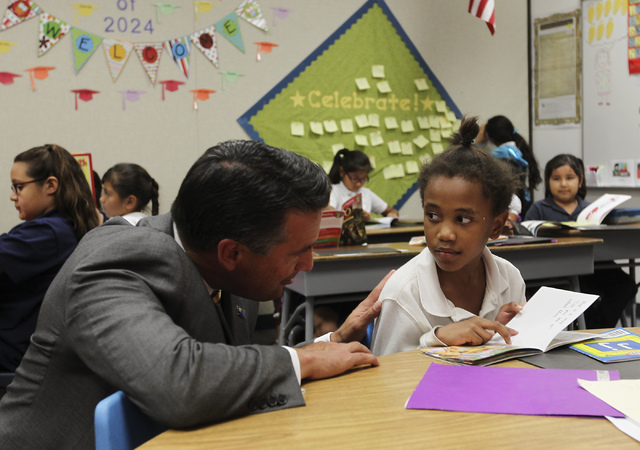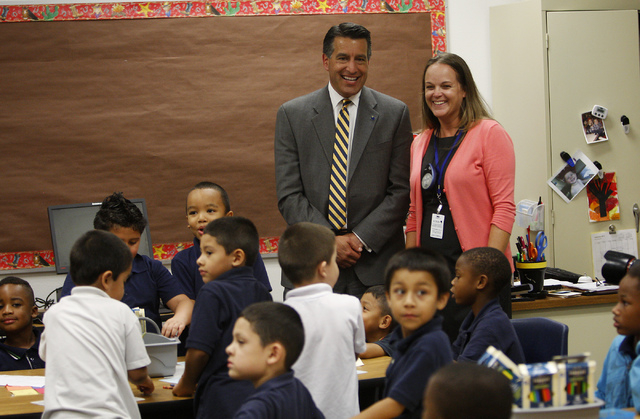Governor checks in on English language learners




A small group of Hispanic kindergartners huddle around their teacher as she demonstrates how to cut on the dotted line.
Entranced, they “Aww” when Kathleen Quigley makes a perfect cut, but they keep glancing at the stranger behind them.
At the back of the room stands Gov. Brian Sandoval.
He’s largely the reason that Quigley won’t be teaching more than 21 students this year or next. Before that, kindergartners had long been split into groups of more than 30 students at Cortez Elementary School.
Sandoval on Friday was at the school, near Tonopah Avenue and Lamb Boulevard, to personally see if this change and others — resulting from his Legislature-approved program to set aside $50 million for special attention to English-learning students – is paying off.
For the first time in Nevada history, money is being provided to schools on top of the usual per-student funding for English-learning students.
“All you have to do is come to a classroom and see the kids, talk to the teachers, to see the benefit,” Sandoval said of the changes in effect for just three weeks. They are already receiving rave reviews from Cortez teachers and the principal. “It’s working.”
The directive: use the money in the state’s lowest-performing schools with the highest populations of English language learners. Clark County School District received $39.4 million and is putting it into 14 elementary schools over the next two school years. The schools are dubbed “zoom schools.”
The plan is to provide full-day kindergarten to all students in reduced class sizes of 21 students. Zoom schools also offer pre-kindergarten to all students, not just a handful of those testing lowest in basic skills, as was previously done. Summer school will also be free and reading skills centers will be opened to get these often struggling students on track.
“Teachers cheered when they heard the news that we were going to be part of the program,” Cortez Principal Patty Rosales said.
The expectation is that students, many of whom enter kindergarten having never spoken a word of English, will catch up with their English-speaking peers. Sandoval toured Cortez after visiting two of Washoe County’s Zoom schools and gleaned from conversations with staff and students that there’s “already some validation.”
But anecdotal evidence won’t suffice for the Legislature, which has required students to be tracked throughout the two years to mark their progress. Lawmakers will decide in 2015 whether to continue the funding.
Danielle Miller, academic manager of Clark County School District Zoom schools, acknowledged extra resources and smaller class sizes comes with increased accountability.
“There are no more excuses,” she said.
The 14 schools will need to show “rapid growth” for their lowest performing students, Clark County Superintendent Pat Skorkowsky said during the tour of Cortez.
The state only has one exam for elementary students, and it’s given once a year in grades three to five. That doesn’t demonstrate whether the money is being well spent with pre-kindergartners and kindergartners. Clark County is spending $11 million of its $19 million allocation for this year on them.
For that reason, all district Zoom students will be assessed using three different tests to judge language skills, fluency and literacy.
“That’s what the Legislature will want to see,” Miller said.
Contact reporter Trevon Milliard at tmilliard@reviewjournal.com or 702-383-0279.


















